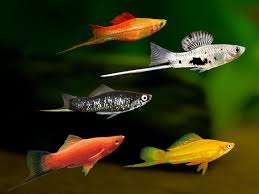
Swordtail Fish
Conditions of detention
Swordtails are hardy and adaptable, making them suitable for a range of aquarium setups. A minimum tank size of 20 gallons is recommended, though larger tanks are preferable for groups. Swordtails prefer water temperatures between 72-82°F (22-28°C) and slightly alkaline water with a pH range of 7.0 to 8.4. They thrive in well-planted tanks with plenty of swimming space, as they are active swimmers. While they can be kept alone, they do best in groups, with a ratio of one male to several females to reduce aggression.
Useful Fact: Swordtails are livebearers, meaning they give birth to live young rather than laying eggs, which can lead to frequent breeding in a well-maintained tank.
Nutrition and diet
Swordtails are omnivorous and require a varied diet to stay healthy. They can be fed high-quality flake or pellet food, supplemented with live or frozen foods such as brine shrimp, daphnia, and bloodworms. They also enjoy vegetable matter, which can be provided through blanched spinach, lettuce, or algae wafers. Providing a balanced diet that includes both plant and protein-based foods helps maintain their vibrant colors and overall health.
Useful Fact: Swordtails have a voracious appetite and may overeat if given the chance, so it’s important to feed them in moderation to prevent obesity and maintain water quality.
Health
Swordtails are generally hardy fish, but they can be susceptible to common freshwater diseases such as ich, fin rot, and internal parasites, especially if water quality is poor. They can also suffer from stress-related illnesses if kept in overcrowded conditions or if there are aggressive tankmates. Regular monitoring of water parameters and maintaining a clean environment are essential for preventing disease.
Useful Fact: Swordtails are known for their resilience, but like all fish, they thrive best in stable water conditions with regular water changes.
Grooming and care
Swordtails do not require traditional grooming, but their environment needs regular maintenance. Given their active nature, frequent water changes (about 20-30% weekly) and strong filtration are necessary to maintain water quality. It’s also important to monitor the population, as they can breed rapidly, leading to overcrowding if not managed.
Useful Fact: Swordtails are prolific breeders, so if you do not want to manage a large number of fry, consider keeping only one gender or providing plenty of hiding spots for the fry to be naturally controlled by tankmates.
Education and training
Swordtails are not typically trained, but they can learn to recognize their owners and will often come to the front of the tank during feeding times. While they are not interactive in the same way as some other species, their active swimming and social behavior make them enjoyable to observe.
Useful Fact: Swordtails are lively fish that enjoy swimming in open areas of the tank, and they often display their best colors when they feel secure in their environment.
Toys and entertainment
Swordtails enjoy exploring their environment, so providing them with a well-decorated tank that includes plants, rocks, and driftwood gives them plenty of places to explore and hide. They are active swimmers, so they benefit from having open swimming areas where they can move freely.
Useful Fact: Swordtails appreciate a tank setup that includes both open spaces for swimming and dense vegetation, which provides them with security and encourages natural behavior.
Safety
Swordtails enjoy exploring their environment, so providing them with a well-decorated tank that includes plants, rocks, and driftwood gives them plenty of places to explore and hide. They are active swimmers, so they benefit from having open swimming areas where they can move freely.
Useful Fact: Swordtails appreciate a tank setup that includes both open spaces for swimming and dense vegetation, which provides them with security and encourages natural behavior.
Accessories
Essential accessories for a Swordtail tank include a reliable filter to maintain water quality, a heater to keep the temperature stable, and a light source that supports plant growth. Swordtails appreciate a tank with plenty of plants, both live and artificial, as well as open areas for swimming. A tight-fitting lid is recommended, as Swordtails can jump.
Useful Fact: Swordtails are active swimmers that benefit from a well-planted tank with plenty of space to swim freely, as well as a secure lid to prevent them from jumping out.
Socialization
Swordtails are social fish and do best in groups. They are generally peaceful and get along well with other community fish of similar size and temperament. However, males can become competitive, so it’s important to monitor their interactions and maintain a balanced ratio of males to females. Swordtails are active during the day and often seen swimming together, making them a lively addition to any community tank.
Useful Fact: Swordtails are livebearers, and females can give birth to fry every few weeks, so it’s important to manage the population or be prepared to care for the young.
Travel and Transportation
When transporting Swordtails, use a plastic bag filled with water from their tank and ensure it is well-oxygenated. Transport them carefully to avoid temperature fluctuations and stress. Keep the bag in a dark, insulated container to minimize stress.
Useful Fact: Swordtails are relatively hardy during transport but should be acclimated slowly to their new environment to reduce stress and prevent shock.
Behavior and psychology
Swordtails are known for their active, social nature and peaceful temperament. They are generally peaceful but can become territorial, especially males, which may chase each other or other fish around the tank. Swordtails are livebearers, and breeding behavior can be frequent in a mixed-gender group. They are most comfortable in groups, where they exhibit natural schooling behavior and active swimming patterns.
Useful Fact: Swordtails are best kept in groups, where they can display their natural behaviors and thrive in a community setting.
Legal aspects
There are generally no legal restrictions on owning Swordtails, but it’s important to ensure they are sourced from reputable breeders or suppliers. As with all fish, ethical sourcing helps support sustainable practices and ensures the health of the fish.
Useful Fact: Swordtails are widely available in the aquarium trade and are often bred in captivity, making them a sustainable choice for home aquariums.


